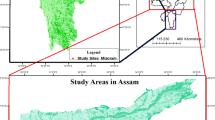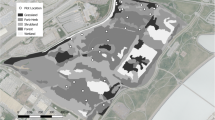ABSTRACT
Given that they represent the most economical option for disposing of refuse, waste landfills are widespread in urban areas. However, landfills generate air and water pollution and require restoration for landscape development. A number of unsanitary waste landfills have caused severe environmental problems in developing countries. This study aimed to investigate the colonization status of different tree species on waste landfills to assess their potential for restoring unsanitary landfills in South Korea. Plot surveys were conducted using 10 × 10-m quadrats at seven waste landfill sites: Bunsuri, Dugiri, Hasanundong, Gomaeri, Kyongseodong, Mojeonri, and Shindaedong. We determined the height, diameter at breast height (DBH), and number of tree species in the plots, and enumerated all saplings ≤1 m high. Because black locust, Robinia pseudoacacia, was the dominant tree species in the waste landfills, we measured the distance from the presumed mother plant (i.e., the tallest black locust in a patch), height, and DBH of all individuals in black locust patches to determine patch structure. Robinia pseudoacacia, Salix koreensis, and Populus sieboldii formed canopy layers in the waste landfills. The basal area of black locust was 1.51 m2/ha, and this species had the highest number of saplings among all tree species. The diameter of the black locust patches ranged from 3.71 to 11.29 m. As the patch diameter increased, the number of regenerated saplings also tended to increase, albeit not significantly. Black locust invaded via bud banks and spread clonally in a concentric pattern across the landfills. This species grew well in the dry habitat of the landfills, and its growth rate was very high. Furthermore, black locust has the ability to fix nitrogen symbiotically; it is therefore considered a well-adapted species for waste landfills. Eleven woody species were selected for screening: Acer palmatum, Albizzia julibrissin, Buxus microphylla var. koreana, Ginkgo biloba, Hibiscus syriacus, Koelreuteria paniculata, Ligustrum obtusifolium, Liriodendron tulipifera, Pinus koraiensis, Pinus thunbergii, and Sophora japonica. As a result of a comparison of the total ratio (sum of shoot extension and diameter growth at the landfill relative to a reference site) and mortality, six species (Liriodendron tulipifera, Albizzia julibrissin, Ligustrum obtusifolium, Buxus microphylla var. koreana, Hibiscus syriacus, and Sophora japonica), which had a total ratio >1 and experienced low mortality, are recommended as potentially suitable species for waste landfill remediation. We suggest that mixed plantations of ubiquitous adaptable species and naturally occurring black locust will enhance the landscape through synergistic effects.




Similar content being viewed by others
Literature Cited
S. E. Allen (1974) Chemical analysis of ecological materials Blackwell Scientific Oxford
J. M. Batzli W. R. Graves P. van Berkum Particlevan (1992) ArticleTitleDiversity among Rhizobia effective with Robinia pseudoacacia L Applied and Environmental Microbiology 58 2137–2143
L. R. Boring W. T. Swank (1984) ArticleTitleSymbiotic nitrogen fixation in regeneration black locust (Robinia pseudoacacia L.) stands Forest Science 30 528–537
Y. S. G. Chan (1997) ArticleTitleRoot growth patterns of two nitrogen-fixing trees under landfill conditions Land Contamination and Reclamation 5 55–62
Y. S. G. Chan M. H. Wong B. A. Whitton (1991) ArticleTitleEffects of landfill gas on subtropical woody plants Environmental Management 15 411–431
Y. S. G. Chan M. H. Wong B. A. Whitton (1996) ArticleTitleEffects of landfill factors on tree cover – A field survey at 13 landfill sites in Hong Kong Land Contamination and Reclamation 4 115–129
H. D. Cho (1999) ArticleTitleThe absorption and purification of air pollutants and heavy metals by selected trees in Kwangju Journal of Korean Forestry Society 88 510–522
Chong, C. W., and L. M. Chu. 2002. Screening native species for revegetating “newly restores” landfills in Hong Kong. Page 46 in Proceedings of the VIII INTECOL International Congress of Ecology, 11–18 August 2002, Seoul
C. K. Converse (1984) Element stewardship abstract for Robinia pseudoacacia. The Nature Conservancy Report Arlington Virginia
T. E. Converse D. R. Betters (1995) ArticleTitleBiomass yield equations for short rotation black locust plantations in the Central Great Plains Biomass and Bioenergy 8 251–254 Occurrence Handle10.1016/0961-9534(95)00034-5
C. S. Crook (1992) ArticleTitleThe feasibility of tree planting on landfill containment sites Arboricultural Journal 16 229–241
M. C. Dobson A. J. Moffat (1999) ArticleTitleExamination on tree and root performance on closed landfills in Merseyside Arboricultural Journal 23 261–272
R. W. Duell I. A. Leone F. B. Flower (1986) ArticleTitleEffect of landfill gases on soil and vegetation Pollution Engineering 18 38–40
Gilman, E. F. 1980. Determining the adaptability of woody species, planting techniques and the critical factors for vegetation completed refuse landfill sites. Ph.D. Thesis, Rutgers University, New Brunswick, New Jersey, 340 pp
E. F. Gilman (1981) ArticleTitleEffects of landfill gas on trees, shrubs and turf Bulletin of the New Jersey Shade Tree Federation 54 13–16
E. F. Gilman (1989) ArticleTitleTree root depth relative to landfill tolerance Hortscience 24 857
Gilman, E. F., I. A. Leone, and F. B. Flower. 1976. Factors affecting tree growth on resource recovery residual landfills. Potential hazards of the heavy metals to plants and animals. Pages 147–153 in Proceedings of 1980 national waste processing conference: Resource recovery today and tomorrow, 15 November, New York
E. F. Gilman I. A. Leone F. B. Flower (1981) ArticleTitleThe adaptability of 19 woody species in vegetating a former sanitary landfill Forest Science 27 13–18
E. F. Gilman I. A. Leone F. B. Flower (1982) ArticleTitleInfluence of soil gas contamination on tree root growth Plant and Soil 65 3–10
E. F. Gilman I. A. Leone F. B. Flower (1987) ArticleTitleEffect of soil compaction and oxygen content on vertical and horizontal root distribution Journal of Environmental Horticulture 5 33–36
InstitutionalAuthorNameGyeonggi Provincial Government (2004) Climate report Gyeonggi Provincial Government Suwon 8
S. J. Hong S. D. Song (1990) ArticleTitleSymbiotic nitrogen fixation activity and environmental factors of Robinia pseudo-acacia L Korean Journal of Ecology 13 93–100
S. Jose A. R. Gillespie S. J. George B. M. Kumar (1996) ArticleTitleVegetation responses along edge-to-interior gradients in a high altitude tropical forest in peninsular India Forest Ecology and Management 87 51–62 Occurrence Handle10.1016/S0378-1127(96)03836-4
R. Kaur B. Buckley S. S. Park Y. K. Kim K. R. Cooper (1996) ArticleTitleToxicity test of Nanji island landfill (Seoul, Korea) leachate using Japanese medaka (Oryzias latipes) embryo larval assay Bulletin of Environmental Contamination and Toxicology 57 84–90 Occurrence Handle10.1007/s001289900159 Occurrence Handle8661464
E. H. Kim H. S. Kim N. C. Sung J. S. Heo (1997) ArticleTitleCharacteristics of leachate with passed time in expired landfill Korean Journal of Environmental Agriculture 16 136–141
Kim, K. D. 2001. Vegetation structure and ecological restoration of the waste landfills in Seoul metropolitan area. Ph.D. Thesis, Seoul National University, Seoul, 186 pp
M. Y. Kim K. H. Kim S. J. Cho M. H. Lee (2002) ArticleTitleThe distribution characteristics of CH4 and CO2 from the infiltrated ventpipes of the Nan-Ji-Do landfill site Journal of Korean Earth Science Society 23 270–279
InstitutionalAuthorNameKorea Landscape Gardening Corporation (1978) Illustrated plants for landscape gardening MyungBoMunHwaSa Seoul 368
K. J. Lee W. Cho B. H. Han (1996) ArticleTitleRestoration and status of urban ecosystem in Seoul Korean Society of Environmental and Ecology 10 113–127
S. M. Lee J. W. Park S. B. Lee (1996) ArticleTitleSurface efflux gas on Nan-Ji Do landfill Journal of Korea Solid Wastes Engineering Society 13 400–406
T. B. Lee (1999) Illustrated flora of Korea HyangMunSa Seoul 990 pp
Leone, I. A., F. B. Flower, J. J. Arther, and E. F. Gilman. 1979. Plant damage from sanitary refuse landfill gases. Pages 215–221 in Environmental pollution and toxicology: Proceedings of international symposium, November, New Delhi
M. Maekawa N. Nakagoshi (1997) ArticleTitleImpact of biological invasion of Robinia pseudo-acacia on zonation and species diversity of dune vegetation in Central Japan Japanese Journal of Ecology 47 131–143
D. Marton (1996) ArticleTitleLandfill revegetation: The hidden assets World Wastes 39 68–76
A. Mavropoulos D. Kaliampakos (1999) ArticleTitleInternational report: uncontrolled landfill investigation —A case study in Athens Waste Management and Research 17 159–164 Occurrence Handle10.1034/j.1399-3070.1999.00029.x
InstitutionalAuthorNameMinistry of Environment (2003) The status of closed waste landfills Ministry of Environment Materials. Ministry of Environment Seoul 38
O. Norgren (1996) ArticleTitleGrowth analysis of Scots pine and lodgepole pine seedling Forest Ecology and Management 86 15–26 Occurrence Handle10.1016/S0378-1127(96)03800-5
A. L. Page R. H. Miller D. R. Keeney (1982) Methods of soil analysis. Part 2. Chemical and microbiological properties American Society of Agronomy, Inc., and Soil Science Society of America, Inc. Wisconsin 1159
T. Panagopoulos A. Hatzistathis (1995) ArticleTitleEarly growth of Pinus nigra and Robinia pseudoacacia stands: contribution to soil genesis and landscape improvement on lignite spoils in Ptolemaida Landscape and Urban Planning 32 19–29 Occurrence Handle10.1016/0169-2046(94)00186-7
R. J. Reinsvold P. E. Pope (1987) ArticleTitleCombined effect of soil nitrogen and phosphorus on nodulation and growth of Robinia pseudoacacia Canadian Journal of Forest Research 17 964–969
G. R. Robinson S. N. Handel (1995) ArticleTitleWoody plant roots fail to penetrate a clay-lined landfill: Management implications Environmental Management 19 57–64
G. R. Robinson S. N. Handel (2000) ArticleTitleDirecting spatial patterns of recruitment during an experimental urban woodland reclamation Ecological Application 10 174–188
M. Sabre D. H. Karen J. Cairns SuffixJr (1994) ArticleTitleAnalysis of patterns of vegetation establishment on a restored landfill Bulletin of the ESA 75 201
InstitutionalAuthorNameSAS Institute (1985) SAS/STAT guide for personal guide SAS Institute Inc. Cary, North Carolina 378
B. H. Sheldrick C. Wang (1993) Particle size distribution M.R. Carter (Eds) Soil sampling and methods of analysis Lewis Publishers Boca Raton, Florida 507–509
E. Simmons (1999) ArticleTitleRestoration of landfill sites for ecological diversity Waste Management and Research 17 511–519 Occurrence Handle10.1034/j.1399-3070.1999.00070.x
R. Sokal F. J. Rohlf (1995) Biometry W. H. Freeman and Company New York 887
J. E. Tosh E. Senior I. A. Watson-Craik (1994) ArticleTitleLandfill site restoration: the inimical challenges of ethylene and methane Environmental Pollution 83 335–340 Occurrence Handle10.1016/0269-7491(94)90155-4 Occurrence Handle15091739
D. Wanru Yue Xilian (1994) ArticleTitleStudy on the rehabilitation of an artificial ecosystem of vegetation on a waste landfill site Huanjing Kexue 15 53–58
S. A. Wilde (1958) Forest soils, their properties and relation to silviculture Ronalt Press New York 537
Woo, J. H., I. S. Ahn, and Y. K Park. 1997. Role of black locust as an environmental tree. Pages 36–55 in Proceedings of black locust research symposium VI, Seoul
P. H. Wyckoff S. L. Webb (1996) ArticleTitleUnderstory influence of the invasive Norway maple (Acer platanoides) Bulletin of the Torrey Botanical Club 123 197–205
C. W. Yun S. H. Oh J. H. Lee S. H. Joo S. C. Hong (1999) ArticleTitlePrediction of succession and silvicultural control in the black locust (Robinia pseudoacacia L.) plantation Journal of Korean Forestry Society 88 229–239
Acknowledgments
This work was supported by Grant R01-2000-00069 from the Basic Research Program of the Korea Science and Engineering Foundation. We are also grateful to graduate students of the Plant Ecology Laboratory, Seoul National University, for their participation. Hyun Ju Song gave invaluable help in the field.
Author information
Authors and Affiliations
Corresponding author
Rights and permissions
About this article
Cite this article
Kim, K.D., Lee, E.J. Potential Tree Species for Use in the Restoration of Unsanitary Landfills. Environmental Management 36, 1–14 (2005). https://doi.org/10.1007/s00267-004-1089-3
Published:
Issue Date:
DOI: https://doi.org/10.1007/s00267-004-1089-3




